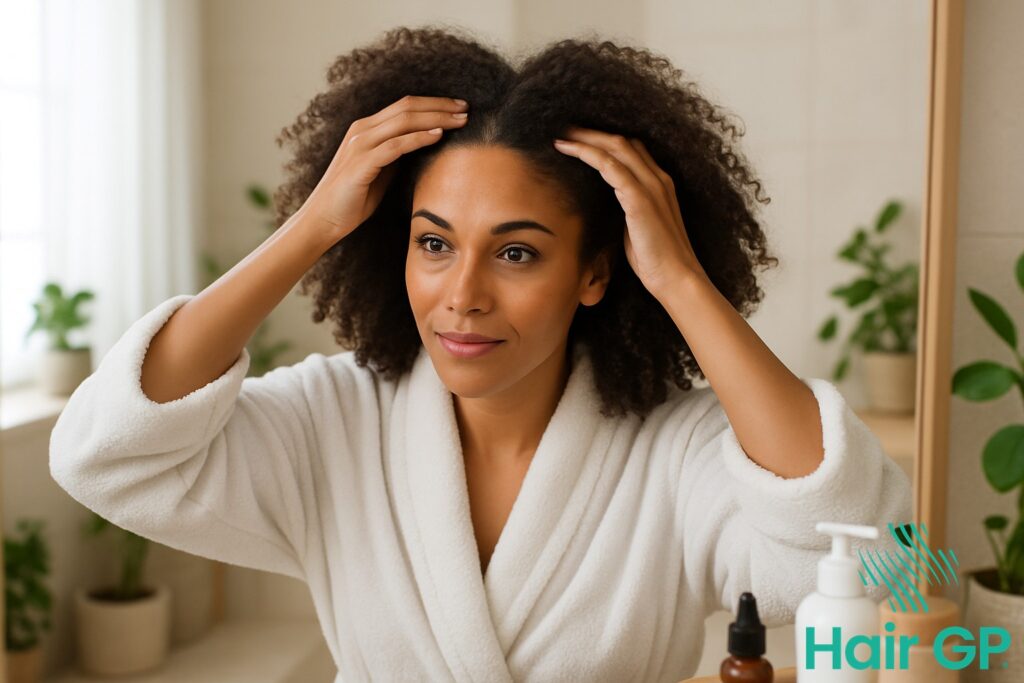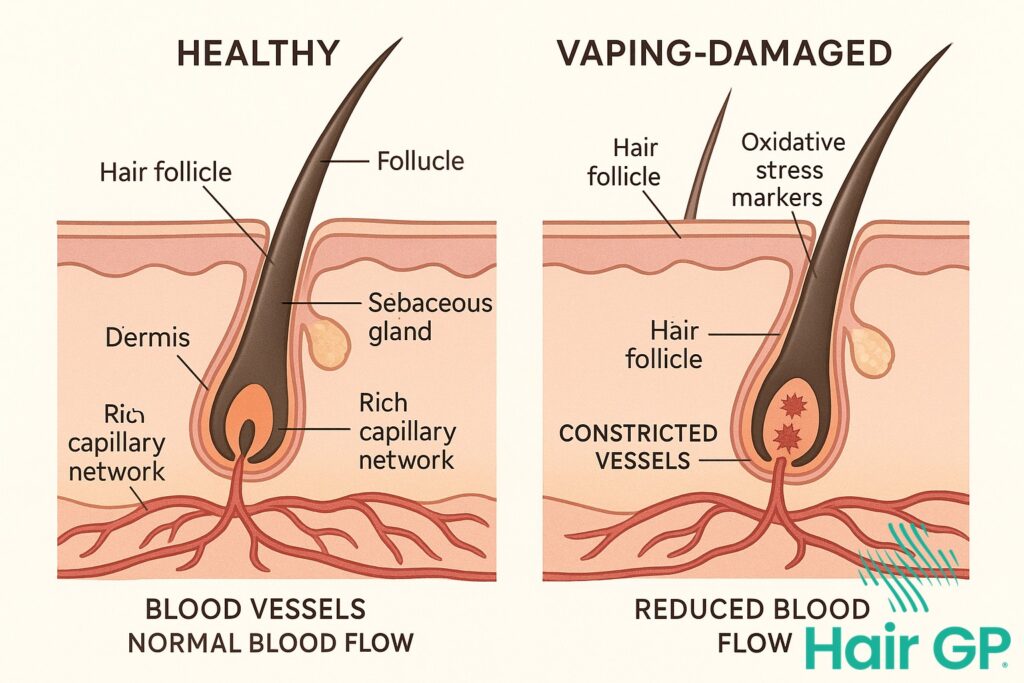Introduction
As temperatures soar and humidity rises, many of us instinctively reach for the simplest hair care solution: letting our locks dry naturally in the summer breeze. It’s a ritual as old as summer itself, based on the assumption that avoiding heat tools equals avoiding heat damage. But here’s where conventional wisdom meets surprising science: air dried doesn’t mean heat free summer haircare myths busted by recent research revealing uncomfortable truths about our favourite warm-weather habits.
The belief that air drying is inherently gentler than blow-drying has become so ingrained in our collective consciousness that questioning it feels almost heretical. Yet emerging evidence suggests that prolonged exposure to environmental heat, UV radiation, and extended moisture retention during natural drying can create a perfect storm for damaged hair. This revelation challenges everything we thought we knew about protecting our tresses during the warmer months.
In this comprehensive guide, we’ll explore the hidden sources of heat damage lurking in seemingly innocent air drying practices, debunk persistent myths about cold water rinses and natural drying superiority, and delve into the fascinating science of how summer elements conspire against our hair health. You’ll discover evidence-based strategies that balance convenience with protection, learn why one-size-fits-all advice rarely works, and find tailored solutions whether you’re blessed with bouncy curls, managing chemically treated strands, or dealing with fine hair that seems to wilt at the first sign of humidity. Prepare to revolutionise your summer hair care routine with insights that might just save your strands.
Key Takeaways – TL/DR
- Air drying in hot summer weather can cause as much damage as blow drying due to environmental heat and UV exposure
- The ‘no heat’ rule for healthy hair is misleading – proper heat styling can actually protect hair better than prolonged air drying
- Different hair types require different summer care strategies, with curly and damaged hair needing extra protection
- Strategic use of heat tools with protectants often results in less damage than hours of air drying in harsh conditions
The Hidden Heat in Air Drying: What Science Reveals
Whilst we often perceive air drying as a heat-free alternative to blow-drying, scientific research reveals that our hair faces significant thermal and structural challenges even without artificial heat sources. Environmental factors, including ambient temperature, UV radiation, and prolonged moisture exposure, create conditions that can lead to protein degradation and cuticle damage comparable to traditional heat styling methods.
Environmental Heat vs Styling Tool Heat
The distinction between natural and artificial heat becomes blurred when examining damage mechanisms. During summer months, ambient temperatures can reach 25-30°C, whilst UV radiation penetrates the hair shaft causing photochemical degradation of proteins [1]. Unlike the controlled, brief exposure from styling tools, environmental heat subjects hair to hours of continuous thermal stress. Humidity compounds this effect, creating a microclimate around wet strands that intensifies heat retention and prolongs the damaging exposure period.
The Wet Hair Vulnerability Factor
Research demonstrates that wet hair exhibits dramatically reduced mechanical strength due to hydrogen bond disruption [2]. When you air dry your hair, the cuticle remains swollen for extended periods, increasing porosity and vulnerability to environmental damage. This prolonged wetness weakens the hair’s protective barrier, making it 30% more susceptible to breakage compared to properly dried strands. The combination of weakened structure and environmental stressors creates ideal conditions for damaged hair, particularly in the cortex where structural proteins reside.
Time vs Temperature: The Damage Equation
The relationship between exposure duration and temperature reveals surprising insights about cumulative damage. Whilst blow-drying exposes hair to 60-80°C for 10-15 minutes, air drying subjects strands to 25-35°C environmental heat for 2-4 hours. This extended exposure allows for significant protein denaturation through slower but persistent thermal degradation. Hair care professionals increasingly recognise that brief, controlled heat exposure with proper protection may cause less overall damage than prolonged environmental exposure. Understanding this equation enables more informed decisions about drying methods, regardless of season or climate conditions.

Summer Hair Care Myths That Need to Die
The world of summer hair care is riddled with well-intentioned advice that’s been passed down through generations, yet much of it contradicts modern hair science. These persistent myths often lead to practices that can actually damage our hair whilst we believe we’re protecting it, highlighting why understanding the truth about summer hair care is essential for maintaining healthy locks throughout the warmer months.
Myth: Air Drying Is Always Healthier
Perhaps the most pervasive belief in summer hair care is that letting your hair dry naturally is always the healthier option. However, air dried doesn’t mean heat free summer haircare myths busted by specialists who point out that environmental conditions play a crucial role in determining whether air drying benefits or harms your hair. In humid climates, prolonged wetness can cause the hair shaft to swell excessively, leading to hygral fatigue – a condition where repeated swelling and contracting weakens the hair structure.
Hair type variations significantly impact how air drying affects your strands. Whilst fine, straight hair might dry relatively quickly without issue, thicker or curly hair can remain damp for hours, creating an environment where bacteria and fungi thrive. Environmental considerations such as UV exposure, pollution levels, and humidity all influence whether air drying or a controlled blow dry would better protect your hair looking its best throughout summer.
Myth: Cold Water Seals Hair Cuticles
The cold water rinse has become gospel in hair care routines, with many believing it magically seals cuticles for shinier hair. Scientific evidence reveals that cuticle behaviour is far more complex than temperature alone can address. Hair cuticles respond primarily to pH levels rather than water temperature, and whilst cold water might temporarily flatten cuticles, it doesn’t create the lasting seal many believe it does.
Temperature effects on hair are minimal compared to using proper conditioning treatments and pH-balanced products. Actual sealing methods involve using acidic rinses, protein treatments, or silicone-based serums that genuinely smooth the cuticle layer and protect against environmental damage.
Myth: Natural Equals Better for Hair
The assumption that natural methods inherently benefit hair health ignores decades of cosmetic science advancement. Whilst natural ingredients can be beneficial, natural doesn’t automatically mean safer or more effective. Modern hair science has developed protective formulations that outperform many traditional remedies in preventing damage and maintaining hair health.
Protection importance cannot be overstated in summer months when UV rays, chlorine, and salt water pose significant threats. Sometimes, scientifically formulated products provide superior defence compared to natural alternatives, ensuring your hair remains healthy regardless of summer activities.
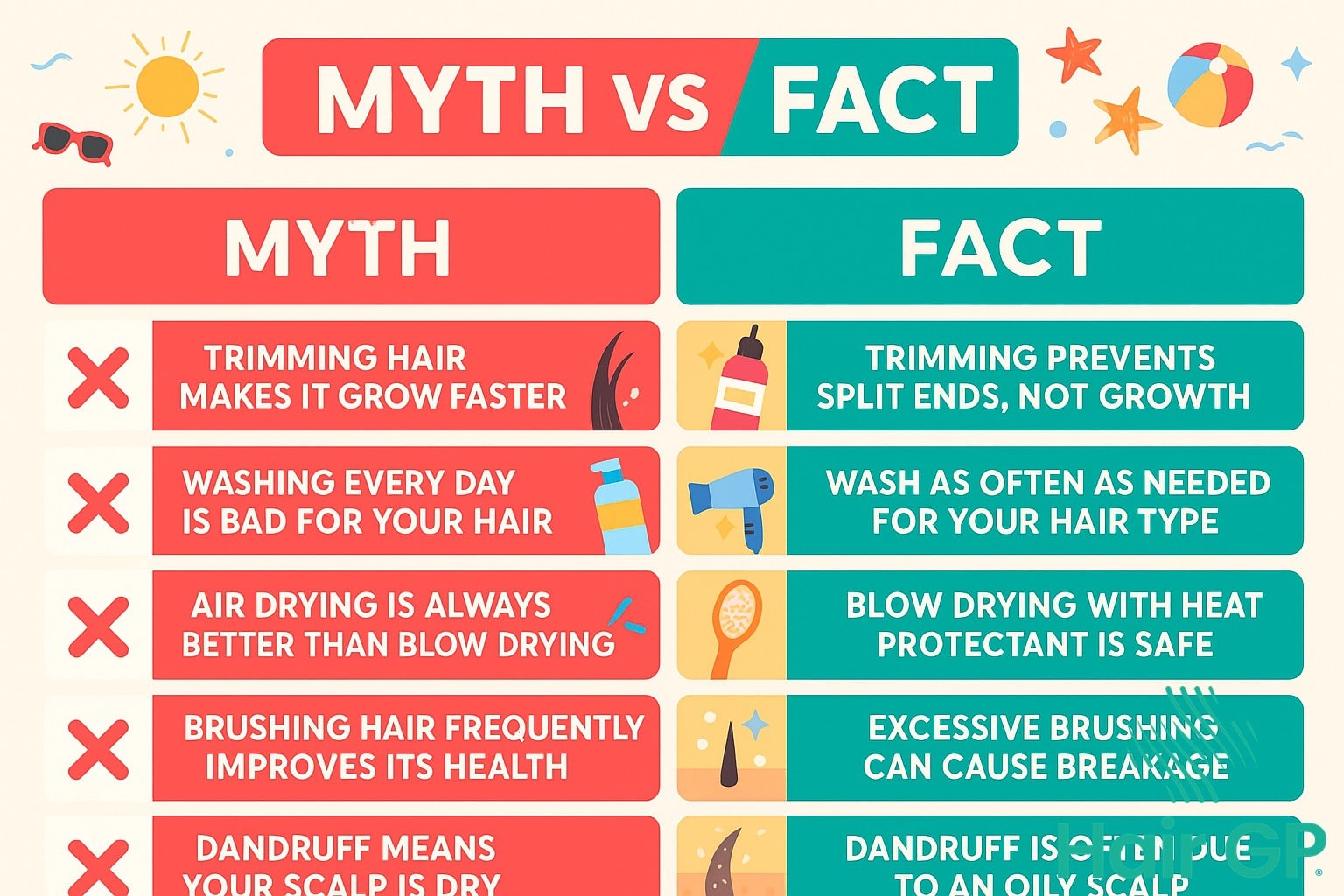
The Science of Summer Hair Damage
Summer presents a unique constellation of environmental stressors that significantly compromise hair integrity. UV radiation penetrates the hair shaft, initiating photochemical reactions that degrade cystine bonds and melanin pigments [3]. This process fragments keratin proteins, creating microscopic voids within the cortex that weaken structural integrity. Prolonged exposure leads to damaged hair characterised by increased porosity, reduced tensile strength, and altered surface properties that affect light reflection and texture.
Humidity exacerbates structural vulnerability through differential water absorption. Research demonstrates that hair fibres can absorb up to 30% of their weight in moisture, causing asymmetric swelling that disrupts the cuticle’s protective barrier [4]. This hygroscopic behaviour creates internal stress patterns that compromise hair growth by weakening the shaft-follicle junction, potentially contributing to seasonal hair loss patterns observed during humid months.
Marine environments introduce additional chemical challenges through salt crystallisation and chlorine exposure. Salt deposits form hygroscopic crystals that continuously draw moisture, creating localised dehydration zones. Chlorine, being a powerful oxidising agent, strips protective lipids and disrupts protein cross-links, leaving hair vulnerable to mechanical damage. When combined with improper drying techniques, these environmental factors create a synergistic effect that accelerates deterioration. Hot air applied to chemically compromised, moisture-laden hair intensifies protein denaturation, while rough towelling on weakened cuticles causes irreversible structural damage. Understanding these mechanisms enables targeted hair care interventions that address specific seasonal challenges rather than applying generic treatments.
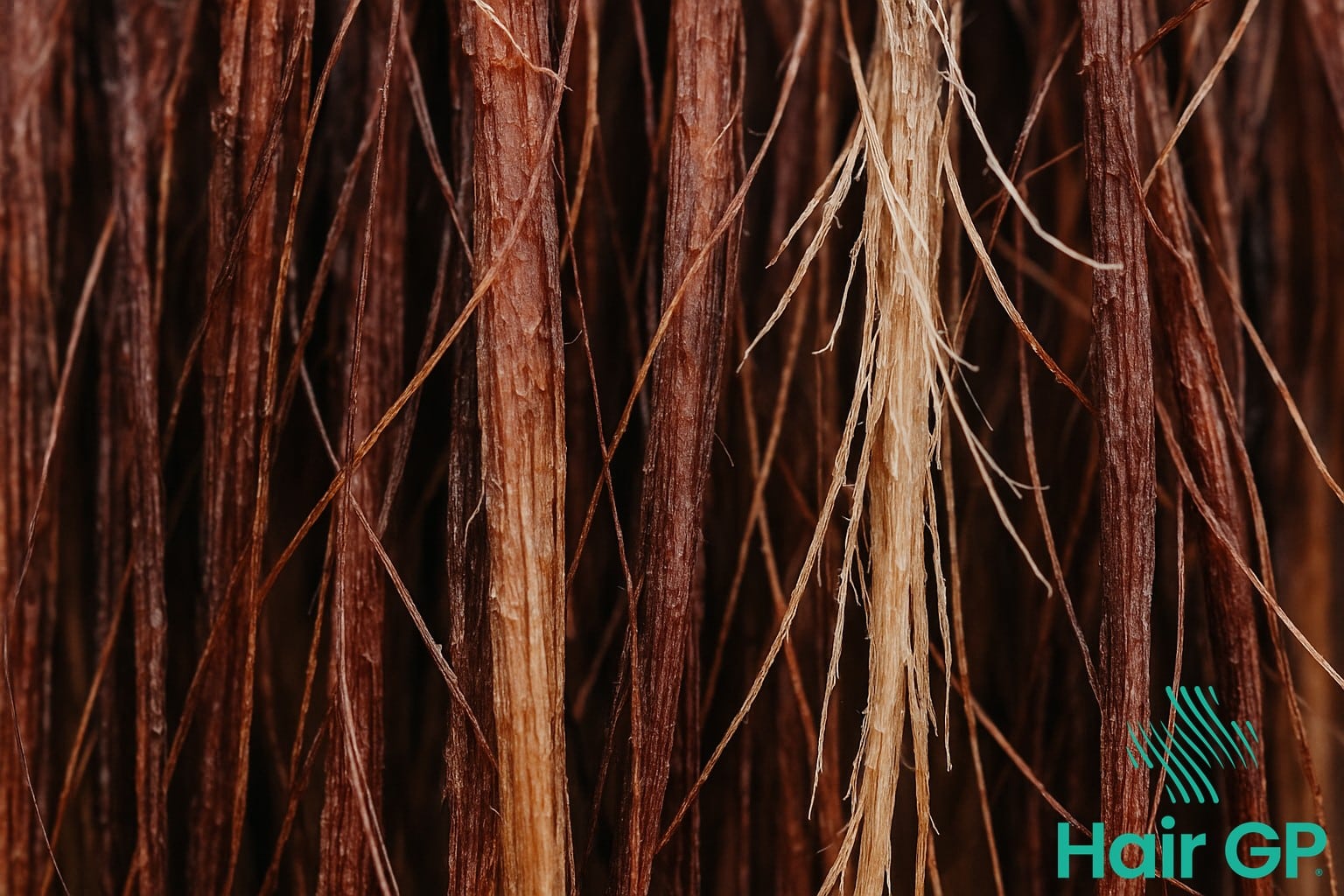
Smart Summer Hair Care Strategies
Achieving healthy summer hair requires strategic approaches that balance practicality with protection. By implementing evidence-based techniques for drying and maintenance, you can keep your hair looking its best whilst minimising damage from both environmental factors and styling practices. These smart strategies adapt to different lifestyles and hair types, ensuring everyone can maintain optimal hair health throughout the warmer months.
The Strategic Blow Dry Method
When you blow dry correctly, you can actually reduce overall damage compared to prolonged air drying. Always apply a heat protectant before styling, focusing on mid-lengths and ends where hair is most vulnerable. Set your dryer to medium heat rather than high, as temperatures above 60°C can cause significant damage. Keep the dryer moving constantly, maintaining a 15-centimetre distance from your hair. Point the airflow down the hair shaft to smooth cuticles and enhance shine. This strategic approach to heat styling minimises exposure time whilst achieving better results than aggressive towel drying or extended air drying periods.
Hybrid Drying Techniques
The most effective hair care approach combines the benefits of both drying methods. After gently squeezing out excess water, allow your hair to air dry until it’s about 60-70% dry. Then, use your blow dryer on a cool or medium setting to finish the process. This timing strategy reduces heat exposure whilst preventing the hygral fatigue that occurs when you dry your hair completely naturally. Finish with a cool shot to seal cuticles and lock in shine, ensuring your hair looking polished and healthy.
Hair Type Specific Summer Solutions
Summer presents unique challenges for different hair types, requiring tailored care strategies to maintain healthy hair growth and appearance. Understanding your specific hair type’s needs ensures better protection against humidity, sun damage, and environmental stressors whilst keeping hair looking its best.
Curly and Coily Hair Summer Care
Curly hair thrives with proper moisture balance during humid summer months. Diffusing on cool settings helps define curls whilst preventing frizz-inducing heat damage. Protective styles like braids or twists minimise manipulation and retain moisture. Deep conditioning treatments weekly maintain hydration levels, whilst leave-in conditioners create barriers against humidity.
Fine and Damaged Hair Protection
Damaged hair requires gentle handling, especially in harsh summer conditions. Air-drying or using microfibre towels reduces breakage compared to vigorous rubbing. Protein treatments fortify weakened strands, whilst lightweight SPF sprays shield from UV damage without weighing hair down. Avoiding hot tools preserves hair integrity during vulnerable summer months.
Colour-Treated Hair Preservation
Maintaining vibrant colour requires UV protection through specialised products or physical barriers like hats. Cool water rinses seal cuticles, preventing colour fade whilst supporting healthy hair looking glossy. Gentle blotting techniques and cool-air drying preserve colour molecules better than heat styling.
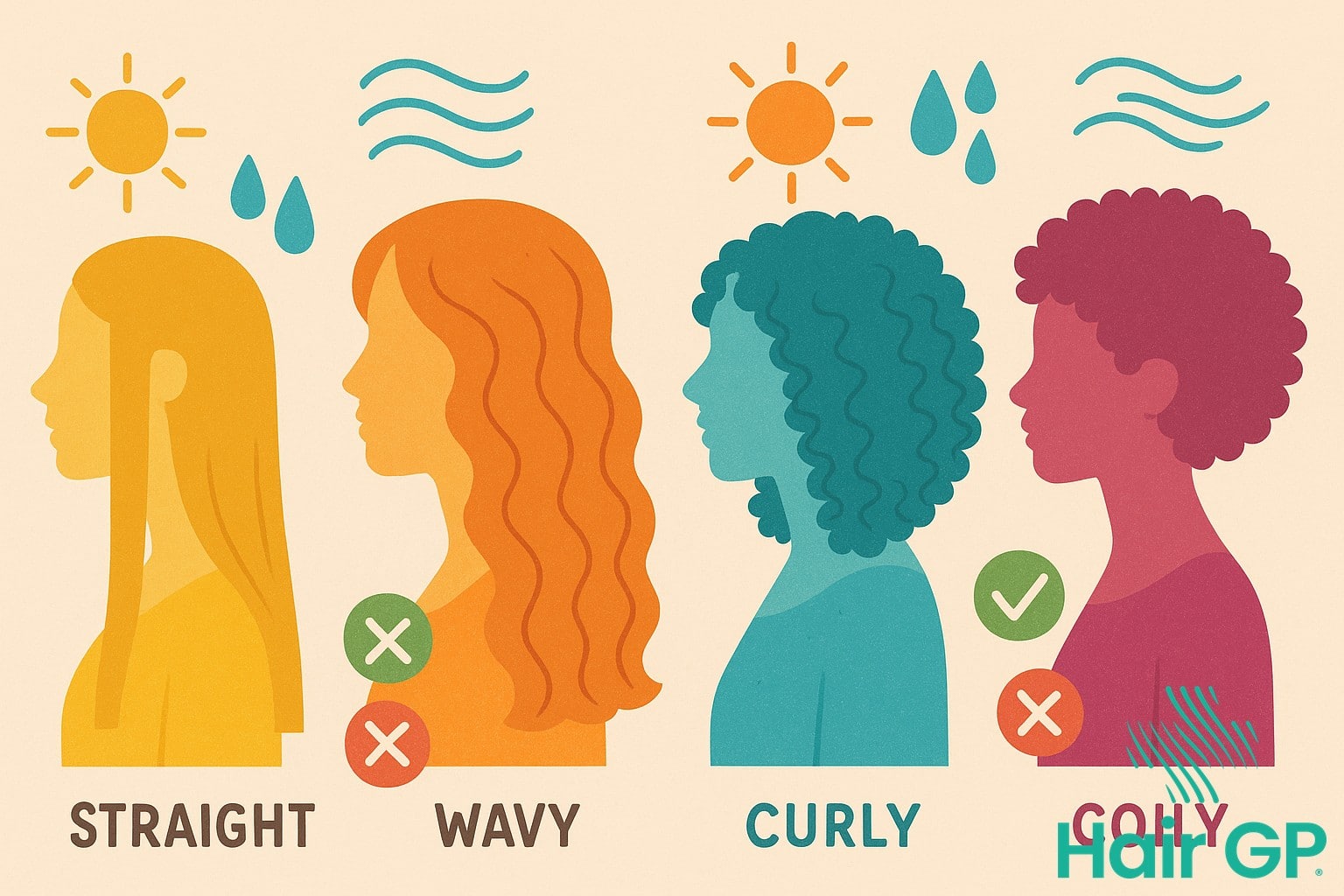
Conclusion
Throughout this exploration of summer hair care misconceptions, we’ve discovered that many widely accepted practices aren’t universally beneficial. As we’ve seen, air dried doesn’t mean heat free summer haircare myths busted by scientific evidence reveal a more nuanced reality. Your individual hair type, texture, and environmental conditions should guide your care routine rather than generic advice that may not suit your specific needs.
The key to effective hair care lies in understanding your unique requirements. Whether you choose to blow dry or air dry, use protective products or go natural, these decisions should be informed by knowledge of your hair’s characteristics and response to different treatments. What works brilliantly for one person might leave another’s hair looking lacklustre or damaged.
Moving forward, approach summer hair care with a critical eye towards popular beliefs. Question conventional wisdom, seek scientific backing for claims, and most importantly, pay attention to how your hair responds to different methods. By prioritising evidence-based practices over trending myths, you’ll develop a personalised routine that keeps your hair looking its absolute best throughout the summer months and beyond.
Frequently Asked Questions
Yes, prolonged air drying, especially in hot, humid conditions, can cause significant damage through extended water exposure, UV radiation, and environmental heat. The key is not avoiding all heat, but using it strategically with proper protection.
For curly hair, use a diffuser on low heat with a heat protectant, or try the ‘plop’ method followed by partial air drying in a controlled environment. Avoid touching hair while drying and use anti-humidity products.
Pre-wet hair with clean water, apply a protective leave-in conditioner, wear a swim cap when possible, and rinse immediately after swimming. Use a clarifying shampoo weekly and deep condition regularly.
Absolutely. Heat protectants create a barrier that reduces moisture loss and protein damage by up to 50%. They’re essential for any heat styling, distributing heat more evenly and preventing hot spots.
References
- Fernández E, Martínez-Teipel B, Armengol R, Barba C, Coderch L. Efficacy of antioxidants in human hair. J Photochem Photobiol B. 2012. PMID: 23123594
- Breakspear S, Noecker B, Popescu C. Relevance and Evaluation of Hydrogen and Disulfide Bond Contribution to the Mechanics of Hard α-Keratin Fibers. J Phys Chem B. 2019. PMID: 31067053
- Robbins C, Weigmann HD, Ruetsch S, Kamath Y. Failure of intercellular adhesion in hair fibers with regard to hair condition and strain conditions. J Cosmet Sci. 2004. PMID: 15386026
- Evans AO, Marsh JM, Wickett RR. The structural implications of water hardness metal uptake by human hair. Int J Cosmet Sci. 2011. PMID: 21923661



